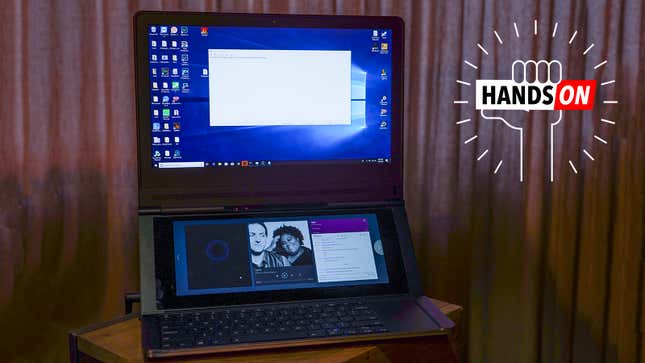
At Computex in Tapei last month, Intel showed off Honeycomb Glacier, a new prototype of a wild laptop with one standard 4K display, and one half-size 4K display right below it. Earlier this week, the company let me check it out at E3, and while it looks goofy, it does present some smart ideas.
Joakim Algstam is one of the people who came up with the prototype. He’s director and section manager of Intel’s Enthusiast Laptop and Innovation Team. His team created the laptop to give OEMs an idea for how to better develop for the dual screen initiatives pressed by Intel and Microsoft, but also because, according to him, more screens means more taxing loads on the CPU which means a better chance to show off Intel’s processing prowess.
So to be clear, this neat little guy is absolutely a marketing ploy by a large company that has seen its chief rival do things like create a 16-core CPU that only needs 105W of power. But damn, if I didn’t dig the funky little folding laptop.

At its most basic, it’s a dual screen laptop like Asus’ new ZenBook Pro Duo and HP’s Omen X 2s. Open the laptop, and enjoy a 4K display in the normal position, and a smaller auxiliary display placed above the keyboard. In a twist, though, there’s a second hinge on the Intel device that lets you lift the displays up so that both are directly in your line of sight.
Intel added a Tobii eye tracker in the hinge between the two displays so that you can activate it by looking at a window. Algstam showed it off by editing text in Note on one screen, then glancing at a Slack window in the other screen and typing without ever reaching for the trackpad. He placed Slack, a music player, and another browser on the smaller window and glanced down any time he needed to interact with any of them.
He also showed some second-screen gaming applications, which looked a lot like what Asus and HP have shown off with their dual display devices. But it’s the combination of Tobii and the hinge that really makes the Intel prototype stand apart.
I kept thinking of my current laptop, a MacBook Pro with a woefully underutilized Touch Bar. I never use the damn thing. I had to take Siri off of it because I kept accidentally activating it when I’d miss the Delete key. (I replaced it with a Do Not Disturb button, so now when I mistype, I just don’t get Slack notifications from my boss for a while.) I like that I can shuttle through a PowerPoint presentation quickly or scrub through an audio file in QuickTime, but that’s basically all it’s good for. The Touch Bar is so tiny that it’s hard to squeeze utility out of it.
The Honeycomb Glacier’s beefier second display is another story. Because it can be a Touch Bar when needed, providing a series of contextual touch buttons, but it’s big enough to handle proper applications.
Too bad it still feels like a tease. HP and Asus are dipping their toes into the field, and Microsoft has repeatedly been rumored to have its own dual display device in the works. Other laptop makers like Dell have insisted dual display devices have a long way to go. But that’s prototypes for you: More future than now.
Correction 6/12/19 1:56pm EST: Intel has since told me the name of the prototype is Honeycomb Glacier, not Twin Rivers. The text has been updated to reflect that.